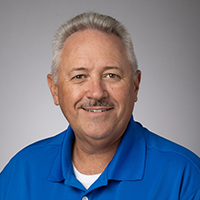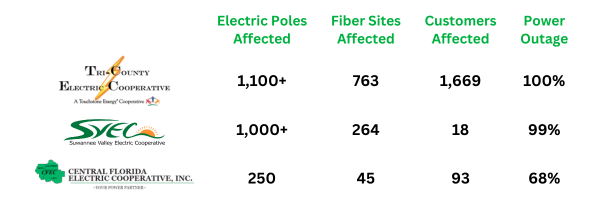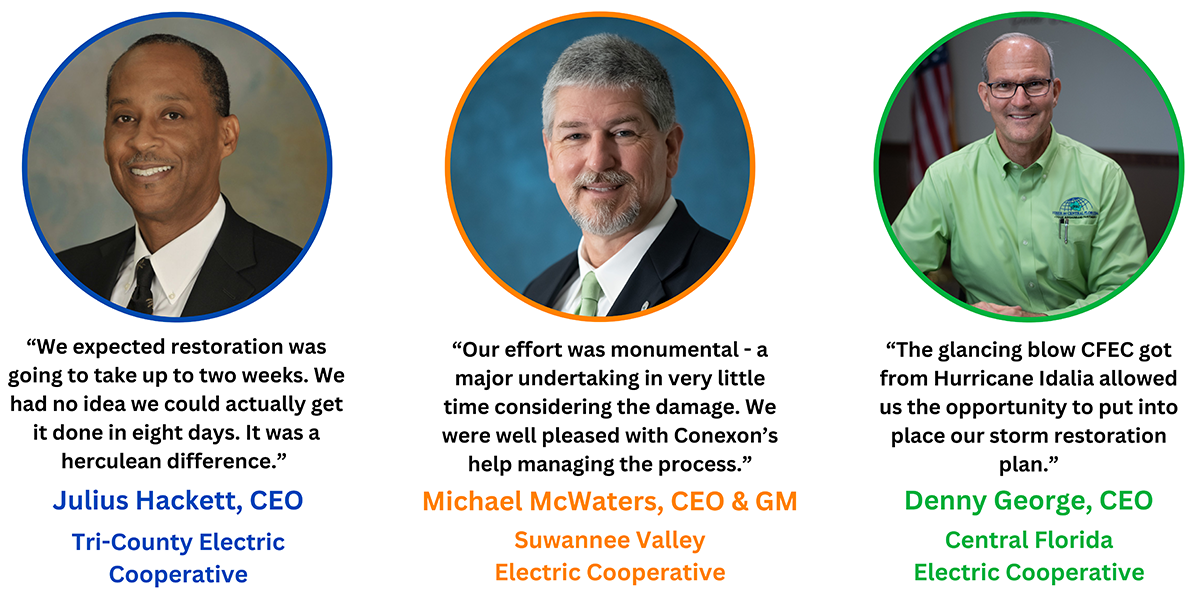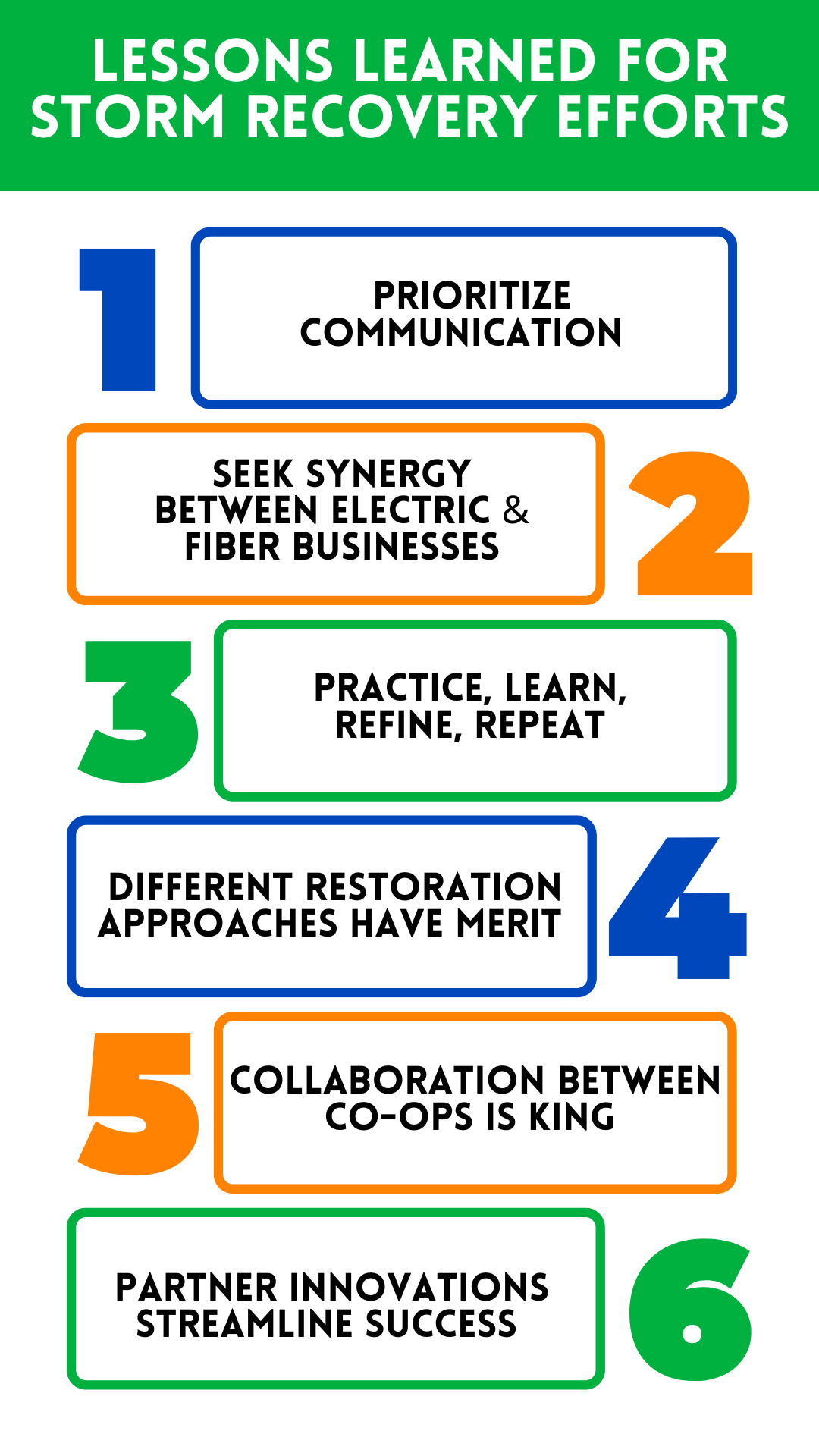Conexon, Electric Cooperative Partners Share Stories From the Storm
Hurricane Idalia, the Category 3 tropical storm that hit Florida’s coastal Big Bend region late in August 2023, wasn’t the first hurricane to impact any of the electric cooperatives in Florida partnering with Conexon to build fiber-to-the-home networks in their service territories. Co-op leaders there are well-versed in the unpredictable nature of the Sunshine State’s storms and the inevitable impact of strong winds and heavy rains on their power lines.
But Idalia was the first storm where Conexon clients Central Florida Electric Cooperative (CFEC), Suwanee Valley Electric Cooperative (SVEC), and Tri-County Electric Cooperative (TCEC) had to worry about electric power lines and fiber-optic lines delivering broadband service. Both were damaged as a result of the winds up to 125 mph as the storm made landfall on August 26.
Idalia was considered the first major hurricane on record to make landfall in this area of the Big Bend, and the storm surges of 7 to 12 feet across coastal counties wreaked havoc with extensive wind and flooding damage to trees and structures that reached inland into Georgia.
For the Conexon fiber broadband teams supporting the electric co-ops in the region, it marked another milestone as well.

"In the days before the storm hit, we told our co-ops to just worry about their electric system – worry about all the things they normally do in a storm. We would be there for them on the fiber broadband side to help restore the damage and manage the process."


“This was the first of Conexon Connect’s projects to require large-scale recovery efforts,” said Ronnie McWhorter, Conexon Construction Project Director. “We handled some restoration after smaller tornado events in Georgia, but Hurricane Idalia was the largest event we’ve been forced to deal with as an ISP, and the only one that affected multiple co-ops.”
In the wake of the storm, CFEC, SVEC and TCEC were all left with widespread power outages and downed lines – a colossal mess to sort out as the co-op teams immediately got to work to assess the damage, the first step toward restoring both electricity and fiber internet service.
“Our project managers communicated with the co-ops in the days before the storm was about to hit and told them to just worry about their electric system – worry about all the things they normally do in a storm. We would be there for them on the fiber broadband side to help restore the damage and manage the process,” McWhorter said. “We know the electric co-ops have plenty to worry about getting the power and lights back on. We’ll take care of the fiber side for you.”
The devastation to the coastal region was extensive, McWhorter explained, and it took days for Conexon’s team of QC assessors, called in from multiple states as far away as Tennessee and Mississippi, to get through all the active feeders to determine the extent of the storm damage.

Extent of Damage
TCEC, the furthest along in its network build with about 1,900 connected subscribers and four fiber huts in place, was hit the hardest, with 735 locations of storm damage to fiber lines requiring repairs. CFEC had about 800 fiber subscribers connected and one fiber hut completed; SVEC, early in its build, had just begun the process of connecting initial customers.
For TCEC, the damage from Idalia was more than ten times what the co-op had sustained in previous storms. “It was unlike anything we had experienced,” CEO Julius Hackett said. “We had 100% blackout of every electric meter in our system and then 100% blackout from the transmission grid as well.”
Despite the total outage, TCEC was able to restore electricity to its members within eight days. “Based on our first assessment of the storm damage and the resources we had in place, we expected the restoration period was going to take up to two weeks,” Hackett said. “We had no idea we could actually get it done in eight days. It was a herculean difference from our previous events.”
For TCEC, the damage from Idalia was more than ten times what the co-op had sustained in previous storms. “It was unlike anything we had experienced,” CEO Julius Hackett said. “We had 100% blackout of every electric meter in our system and then 100% blackout from the transmission grid as well.”
Despite the total outage, TCEC was able to restore electricity to its members within eight days. “Based on our first assessment of the storm damage and the resources we had in place, we expected the restoration period was going to take up to two weeks,” Hackett said. “We had no idea we could actually get it done in eight days. It was a herculean difference from our previous events.”

SVEC CEO and General Manager Michael McWaters echoed Hackett’s feelings about the scope of restoration required and the ease with which it all came together in the end. With the Conexon team working alongside the co-ops to mitigate and repair damaged lines, what could have been an overwhelming task was streamlined and simplified.
“Our effort was monumental – a major undertaking done in a very little amount of time considering the damage we had,” McWaters said. “We were well pleased with Conexon and to have their help managing the process. All our contractors did a great job of helping us get to the damage and get it restored quickly.” The co-op restored electricity to 95 percent of its customers within eight days, with the average fiber restoration timeline of just four days.
At CFEC, the “glancing blow” of storm damage meant that CEO Denny George and his team were able to restore fiber service within two days after the storm, and the fiber restoration efforts were done by in-house personnel rather than outside contractors. Electricity was restored to the co-op-standard 95 percent threshold within five days after Idalia hit.
One of Conexon’s biggest challenges was the transmission grid blackout to all substations that affected both TCEC and SVEC, leaving Conexon without power to operate the fiber huts in place. Once initial storm damage had been cleared and it was safe to do so, Conexon brought in five generators from Kentucky, Georgia, and South Florida to power the restoration efforts.
Remarkably, even in the storm-torn areas, multiple Connect customers with their own home generators were still receiving internet service because their in-home network equipment had power to receive the fiber connection. About 120 customers across the region stayed connected to high-speed fiber internet throughout the storm.
“We were determined to try to keep all those folks on because it may be their only lifeline,” McWhorter said. “Those homes with Wi-Fi were using it to communicate out into the world and letting their neighbors come over to do the same thing.”
Timeline of Restoration
Because Conexon fiber networks follow the electrical infrastructure, broadband technicians and crews couldn’t begin the process of restoring internet connections until electrical power for the customer was restored first.
Despite the multi-step process contingent on the co-ops’ ability to restore electricity swiftly, Conexon completed fiber restoration to 99 percent of customers within one month of hurricane landfall. McWhorter estimated that 270 additional contract personnel and 32 additional Conexon personnel were called in to facilitate Conexon’s efforts. Crews were working 12-hour days or longer in the field, commuting to overnight accommodations as far away as two hours, and often still entering data in the evenings because there was no cell service in the field.
“It was daylight to dark for the co-ops and our teams for days on end,” McWhorter said.
Conexon’s damage assessment started about two days after the storm and was finished within five days. At the same time, the co-ops were assessing electrical damage and beginning their own restoration processes, including tree removal and clean-up. Fiber restoration was started within one week of hurricane landfall. Once power was restored in an area, broadband construction crews could rehang the fiber. Then, splicing crews came in to do repairs and finally, install crews reconnected service to the premises.
In spite of widespread devastation, the fiber restoration process took less than four weeks start to finish from the initial impact of Idalia.

Lessons Learned From Hurricane Idalia
1. PRIORITIZE COMMUNICATION
“Because our fiber build was so new to us, it was more of an afterthought in this storm and we let Conexon handle it. But awareness of the full organization should incorporate fiber – it needs to be more top of mind moving forward. We are going to tightly coordinate our future emergency response plans so we have a clear communication channel on the fiber side to make sure all aspects are considered in these major discussions.”
Julius Hackett, TCEC
2. SEEK SYNERGY BETWEEN ELECTRIC & FIBER BUSINESSES
“This was the first major test for SVEC as a co-op in the fiber business. Our experience during this storm, though unfortunate to happen so early in our fiber build, gives us a better idea of what to expect in the future. As we move forward and more events happen, we know that making sure there is clear communication and coordination between the electric side and the fiber side is key to success.”
Michael McWaters, SVEC
3. PRACTICE, LEARN, REFINE, REPEAT
“We run mock drills each year. We review the storm plan because roles change and duties shift. Then we have a mock storm in the spring that we think through. Idalia was fabulous for us because we got a glancing blow, and we got to execute the mechanics of our plan.”
Denny George, CFEC
Even before Idalia hit, TCEC had been thinking about how to scale up the co-op’s emergency response plan. They hired a consultant to assist with planning, who led TCEC through a more robust storm rehearsal in July. “In terms of mindset, we had been thinking about storm recovery efforts for weeks, even before we were actually negatively impacted.”
Julius Hackett, TCEC
4. DIFFERENT RESTORATION APPROACHES HAVE MERIT
The restoration approach that worked for SVEC was to start from the substation and work outward by feeder. When electric restoration was complete for a feeder, it was then released to the fiber operations manager to begin work on the fiber damage – allowing the feeders to be systematically restored in full.
Michael McWaters, SVEC
TCEC’s restoration efforts focused on assessing where the heaviest damage occurred and allocating more resources to those areas. “We wanted to balance recovery. We prioritized so that the areas with the most damage also had the most resources sent. As more resources became available, we were able to assign a larger workforce to where it was needed most.”
Julius Hackett, TCEC
5. COLLABORATION BETWEEN CO-OPS IS KING
George focused on the universality of “co-ops helping co-ops” that continued even in the height of the hurricane’s aftermath. Within 12 hours of completing its own power line restoration, CFEC sent its lineworkers to TCEC to begin to assist there. “We’d love to have more thoughtful conversations together with Conexon and all three co-ops involved about the fiber construction techniques and how it performed through the storm.”
Denny George, CFEC
“Once the storm clears the general area and you have surrounding co-ops and surrounding states that are no longer in harm’s way, they begin releasing resources. Every day would go by and we would see more resources start to come to the area. That effort from everyone involved is what I’m most proud of: They were tasked with extremely long hours to help restore power and instead of complaining, they were energized by the opportunity to step up big for our community.”
Julius Hackett, TCEC
6. PARTNER INNOVATIONS STREAMLINE SUCCESS
“Conexon is built for building fiber. Our restoration efforts were well-executed, but we have some work to do on our side to be better prepared in the next storm. As we grow and connect more customers on more projects, the efforts required are going to multiply dramatically. We identified a lot of best practices to be put in place going forward.”
Ronnie McWhorter, Conexon Construction Project Director
One Conexon innovation already underway before Idalia was a storm damage tracker tool. The software allows QC assessors to identify the issues in the field more easily, record an entry for the damage that includes the location and pole number, and capture and upload photos. The records can be sent to project managers, fiber contractors, and splicers so that specific restoration tasks can be assigned. “We’ve tried to tailor our tool to what the co-ops told us they needed because we knew this day was coming. It worked well for us during Hurricane Idalia.”
Ronnie McWhorter, Conexon Construction Project Director